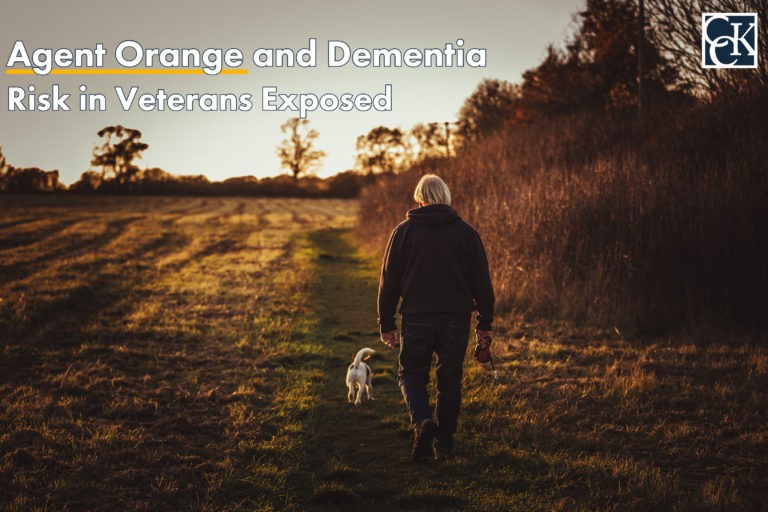Agent Orange and Dementia Risk in Veterans Exposed

CCK Law: Our Vital Role in Veterans Law
A new study published by JAMA Neurology examined the relationship between Agent Orange exposure and dementia. The study examined more than 300,000 veterans who served during the Vietnam War era.
Tracing the Link Between Agent Orange and Dementia
The new study sought to “examine the association between Agent Orange exposure and incident dementia diagnosis” among US veterans who served during the Vietnam War era. The study was conducted using information from the Veterans Health Administration between October 1, 2001 and September 30, 2015.
The study sampled 2 percent of US veterans who served during the Vietnam War era and had received care from the Veterans Health Administration. The sampled population excluded those who initially had dementia, those who did not receive follow up care, and those whose exposure to Agent Orange may have been unclear.
In total, 316,351 veterans were analyzed. The veterans were primarily male. The average age 62. Approximately 38,121 veterans had presumed Agent Orange exposure, presenting with conditions such as Parkinson’s Disease, diabetes, and amyloidosis.
Agent Orange and Dementia: The Increased Risk
The study indicated that veterans who were exposed to Agent Orange were nearly twice as likely to become diagnosed with dementia over the 3.8 years following the study’s start than those not exposed to Agent Orange. Ultimately, veterans exposed to Agent Orange tended to develop dementia, on average, 1.25 years earlier than their counterparts without Agent Orange exposure.
The study adjusted for competing risk of death, demographic variables, and medical and psychiatric comorbidities, yet the results still conclusively indicated that veterans who were exposed to Agent Orange faced twice the risk of being diagnosed with dementia.
One of the authors, Deborah E. Barnes, noted in an interview that 5 percent of Vietnam veterans who were exposed to Agent Orange were diagnosed with dementia. Comparatively, 2,5 percent of Vietnam Veterans who were not exposed to Agent Orange developed dementia.
Agent Orange Exposure and Health Conditions: Presumptive Service Connection
Agent Orange is one of the several herbicides, often known as “rainbow herbicides,” that was used by the United States during the Vietnam War era. Agent Orange is composed of a mixture of two kinds of herbicide agents, 2, 4-D and 2, 4, 5-T. The highly toxic dioxin contaminant known as 2, 3, 7, 8-TCDD is a byproduct that is produced by Agent Orange. This toxic dioxin contaminant has caused many serious health conditions in Vietnam War Veterans.
The Agent Orange Act of 1991 established a presumption of service connection, meaning that VA must recognize that veterans who served in specific locations at specific time periods were exposed to Agent Orange. The presumptive service connection list includes the following locations and time-periods:
- Boots-on-the-ground in Vietnam, veterans with service aboard a ship that operated in the inland waterways of Vietnam (i.e., Brown Water veterans), or veterans with service aboard a ship in Vietnam’s territorial seas (i.e., Blue Water Navy veterans) between January 9, 1962 and May 7, 1975
- On or near the Korean demilitarized zone (DMZ) between September 1, 1967 and August 31, 1971
- Active duty and reservist personnel who had regular contact with C-123 aircraft between 1969 and 1986
Additionally, veterans who served in these locations during these time periods do not have to prove a medical nexus between their condition and their military service, so long as their condition is on VA’s list of presumptive conditions. The list has been periodically added to over time, through the passing of new regulations and statutes. The following list contains the current Agent Orange-related conditions that are approved for presumptive service connection:
- AL Amyloidosis
- Bladder Cancer
- Chronic B-Cell Leukemia
- Chloracne (if it presents within one year of exposure to a degree of 10 percent disabling)
- Diabetes Mellitus Type 2
- Hodgkin’s Disease
- Hypothyroidism
- Ischemic Heart Disease (including Coronary Artery Disease, stable and unstable angina, myocardial infarction, and sudden cardiac death)
- Multiple Myeloma
- Non-Hodgkin’s Lymphoma
- Parkinson’s Disease
- Parkinson’s-like symptoms
- Peripheral Neuropathy, Early Onset (if it presents within one year of exposure to a degree of 10 percent disabling)
- Porphyria Cutanea Tarda (if it presents within one year of exposure to a degree of 10 percent disabling)
- Prostate Cancer
- Respiratory Cancers, including Lung Cancer
- Soft Tissue Sarcomas (other than osteosarcoma, chondrosarcoma, Kaposi’s sarcoma, and mesothelioma)
As of 2021, Congress passed the NDAA, or National Defense Authorization Act, bypassing VA to add three conditions to the list:
- Bladder cancer
- Hypothyroidism
- Parkinson’s-like symptoms
The Agent Orange Act of 1991 made specific provisions giving the Secretary of the Department of Veteran Affairs the power to add conditions to the list of presumptive conditions over time. Congress, through legislation like the NDAA, also has this power.
Will Dementia Be Added to the List of Presumptive Conditions?
The process for adding conditions to the list of presumptive can often take many years and much debate. The Agent Orange Act of 1991 stipulates that VA’s Secretary is required to contract with the Institute of Medicine (IOM). Every two years, at minimum, the IOM is to submit a report that analyzes the link between herbicides used during service and certain health conditions. The IOM uses data from VA medical exams and treatment provided to Vietnam Veterans who sought treatment after 1981 for Agent Orange exposure.
The IOM is tasked with determining whether there is statistical evidence that supports the link between exposure to herbicides and a specific disease. The VA Secretary can then determine that a positive association exists, if this is the case, and that presumptive service connection is warranted.
In past instances, Congress has pressured VA to add conditions to the list. Specifically, in January of 2020, VA Secretary Wilkie reported “significant concerns and limitations” with several IOM studies concluding that there is suggestive or sufficient evidence linking bladder cancer to Agent Orange exposure. By March of 2020, a bill was introduced in response to the VA’s ongoing delays to add bladder cancer to the list of presumptive conditions. Finally, the 2021 NDAA was passed by Congress and determined by statute that the condition be added to the list.
Though the process required to add dementia to the list of presumptive conditions could be long and complicated, scientific studies such as the one published could help provide evidence linking dementia to Agent Orange exposure.
About the Author
Share this Post
